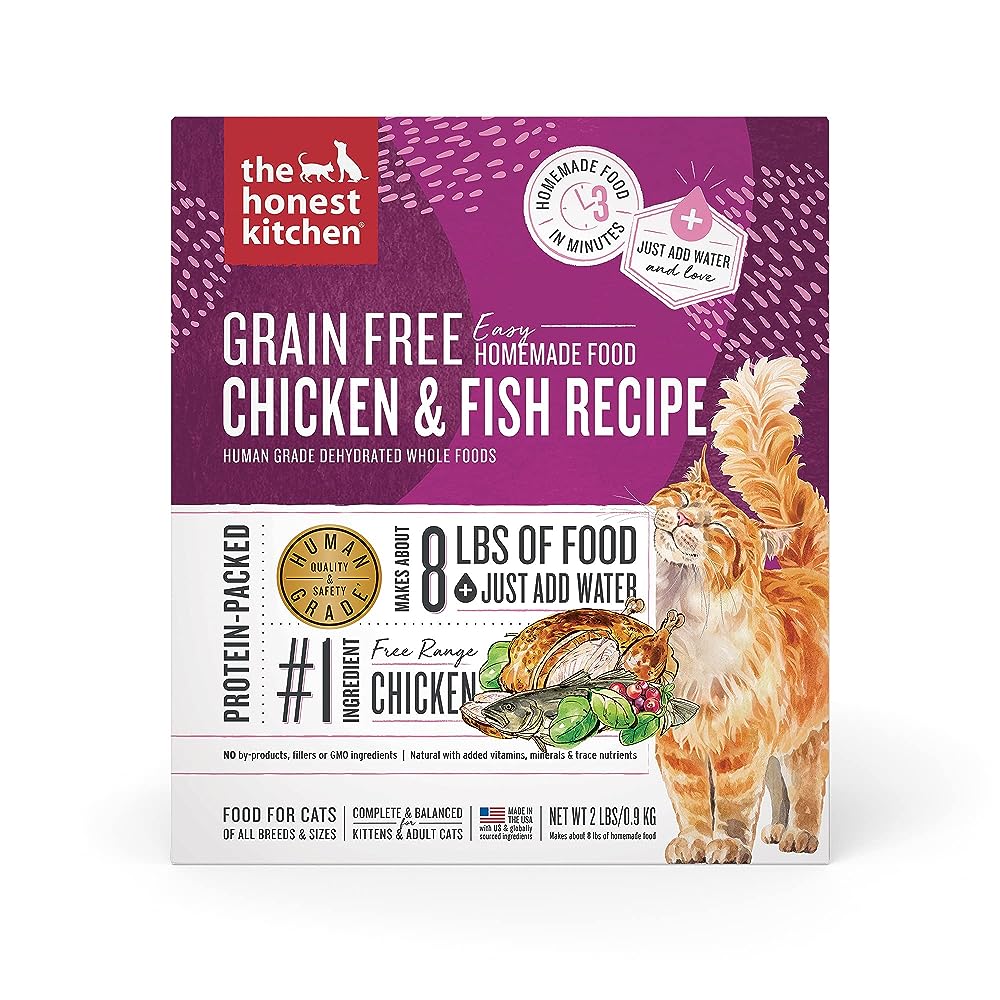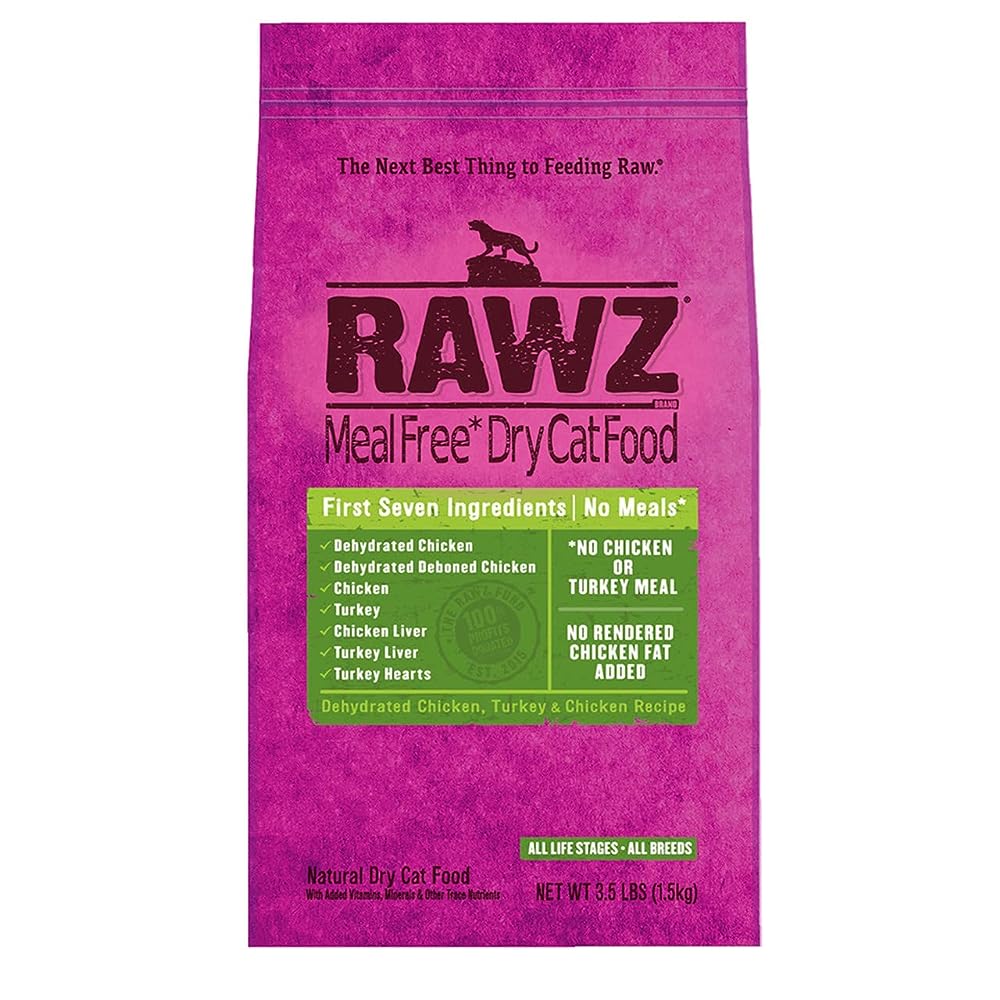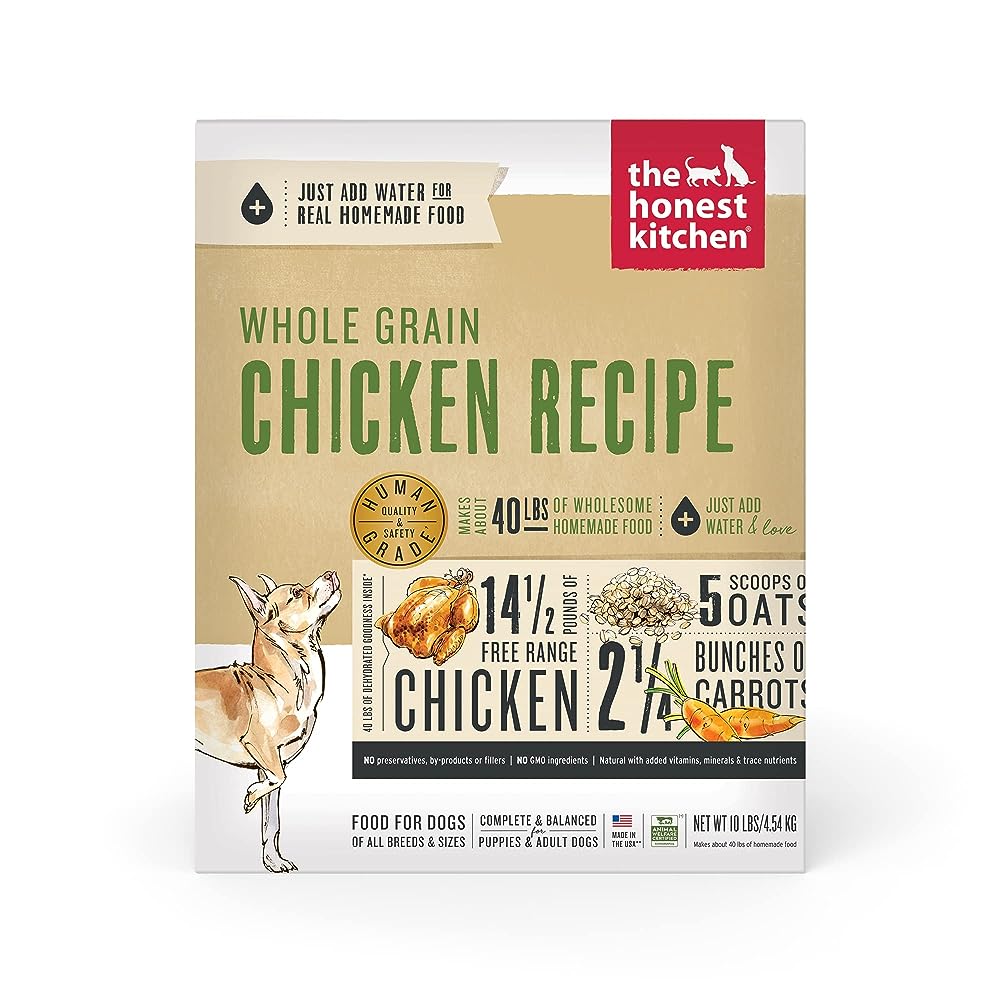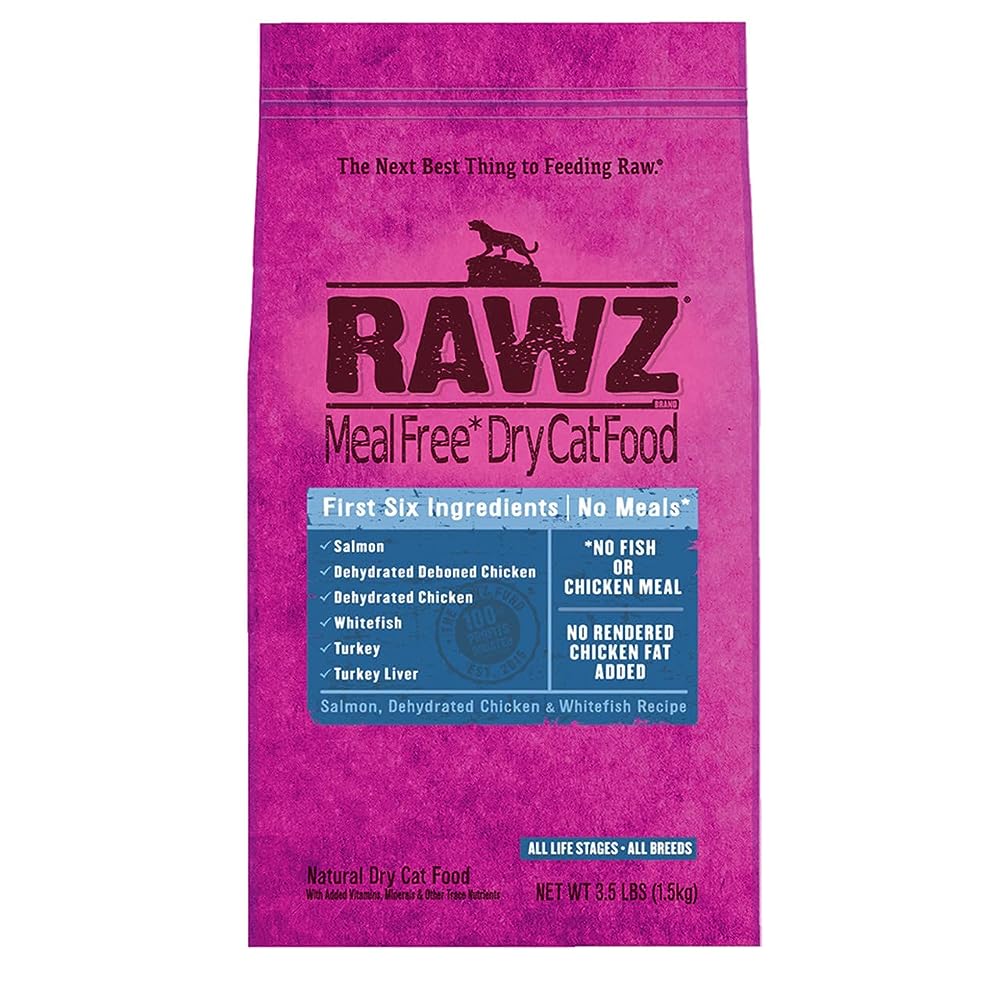As cat owners become increasingly conscious about providing their feline friends with high-quality and nutrient-rich diets, the popularity of dehydrated cat food has seen a substantial rise. Unlike traditional kibble or canned food, dehydrated cat food offers a convenient way to serve up real, raw nutrition without the hassle. This guide aims to delve into the nuances of dehydrated cat foods and help you select the best options available on the market, ensuring a diet that aligns with both your cat’s nutritional needs and your lifestyle.
#1 – The Honest Kitchen Dehydrated Grain Free Chicken & Fish Cat Food, 2 lb Box
The Honest Kitchen Dehydrated Grain Free Chicken & Fish Cat Food is a high-quality cat food that is made with real whole food ingredients and is gently dehydrated for maximum taste and nutrient retention. It is packed with protein from free-range chicken and wild-caught white fish, making it a delicious and nutritious option for cats. It is also free of artificial preservatives, fillers, and GMO ingredients, and it is made in the USA with trusted sources from around the world.
Best For: Cats of all life stages, breeds, and sizes. High-quality, natural cat food
#2 – Rawz Meal Free Dry Cat Food Dehydrated Chicken, Turkey Chicken Recipe (3.5 lb)
Rawz Meal Free Dry Cat Food is a nutritionally complete and balanced diet for cats of all ages. It is made without gums, additives, or rendered ingredients. The food is gently cooked in smaller batches and cooked to ensure food safety. It contains healthy levels of highly digestible protein and reduced carbohydrates, with dehydrated chicken as the main protein source.
#3 – The Honest Kitchen Human Grade Dehydrated Whole Grain Dog Food – Complete Meal or Topper – Chicken 10 lb (makes 40 lbs)
The Honest Kitchen Human Grade Dehydrated Whole Grain Dog Food is a complete and balanced meal option for dogs. It can be served alone as a homemade meal or used as a topper for dry food. Made with human-grade, free-range chicken and other wholesome ingredients, it is suitable for both puppies and adult dogs of all sizes. Additionally, this product is free from preservatives, by-products, fillers, GMO ingredients, corn, wheat, and soy.
Best For: Best ingredient sourcing.
#4 – RAWZ Dehydrated Salmon, Chicken, and Whitefish Recipe for Cats – 3.5 LB BAG
The RAWZ Dehydrated Salmon, Chicken, and Whitefish Recipe for Cats is a 3.5 lb bag of premium cat food. Made with real salmon, chicken, and whitefish, this grain-free and potato-free recipe provides a high-protein meal for cats. It is best for cats who require a high-protein diet.
What Should I Look For When Choosing a Dehydrated Cat Food?
When choosing a dehydrated cat food, there are several factors to consider to ensure you’re providing the best nutrition for your feline friend:
- Quality of Ingredients: Look for a product that lists high-quality, whole-food ingredients. Protein should be the first ingredient, and it’s better if it comes from a specified, recognizable source like chicken, beef, or fish rather than a generic “meat” label.
- Nutritional Balance: Ensure the food meets the AAFCO (Association of American Feed Control Officials) guidelines for a balanced diet. It should have an appropriate balance of protein, fat, and carbohydrates, along with essential vitamins and minerals.
- No Fillers or Additives: High-quality dehydrated cat food should not contain unnecessary fillers like corn, wheat, or soy, which offer little nutritional value. Additionally, avoid products with artificial preservatives, colors, or flavors.
- Ease of Preparation: Dehydrated food requires rehydration. Check the preparation instructions to see if the process is straightforward and if you’ll be able to easily incorporate it into your daily routine.
- Price and Brand Reputation: While higher-priced foods are often of better quality, this is not a hard rule. Research the brand, read reviews, and perhaps consult your veterinarian for recommendations tailored to your cat’s specific health needs.
Always consult your veterinarian before making significant changes to your cat’s diet, especially if they have specific health concerns or dietary requirements.
What Are The Benefits of Dehydrated Cat Foods? What Are The Downsides?
Dehydrated cat foods offer a variety of benefits but also come with some downsides that are worth considering:
Benefits:
- Nutrient Preservation: The dehydration process generally preserves more of the natural nutrients in the food compared to traditional cooking methods. This is because dehydration usually involves lower heat levels and no exposure to direct flame or boiling water.
- Long Shelf Life: Dehydrated foods have a much longer shelf life compared to wet or fresh foods. This makes them convenient for long-term storage and less prone to spoilage.
- Convenience: Dehydrated foods are lightweight and take up less storage space, making them convenient for traveling or camping trips with your feline friend. Plus, they are easy to prepare; usually, you just need to add water.
- Less Processing: Typically, dehydrated foods undergo fewer processing steps compared to kibble or canned foods, which may retain more of the natural flavors and nutrients.
Downsides:
- Cost: Dehydrated foods are often more expensive than kibble or wet foods. The high-quality ingredients and specialized processing methods can add to the cost.
- Preparation Time: Dehydrated foods require rehydration, which means you’ll need to add water and wait for the food to reach the right consistency. This can be an inconvenience if you’re used to more ‘grab-and-go’ options like kibble.
- Palatability: While many cats enjoy the taste of rehydrated food, some may not like the texture or flavor, especially if they are accustomed to wet or kibble foods.
- Caloric Density: Because water is removed, dehydrated foods are calorically dense. It’s crucial to follow feeding guidelines to prevent overfeeding and subsequent weight gain.
As with any dietary change, consult your veterinarian to discuss what is most appropriate for your cat’s specific health needs and lifestyle.
Frequently Asked Questions About Dehydrated Cat Foods
- What is dehydrated cat food? Dehydrated cat food is made by removing most of the moisture from the ingredients, preserving them in a dry state. This process helps retain many of the natural nutrients in the food while providing a long shelf life. To feed it to your cat, you’ll typically need to add water to rehydrate the food.
- Is dehydrated cat food better than kibble? Dehydrated cat food and kibble both have their pros and cons. Dehydrated food usually retains more natural nutrients and flavors, but it is often more expensive and requires rehydration before feeding. Kibble is more convenient and typically cheaper but may contain fewer nutrients due to the high-heat cooking process.
- How long does dehydrated cat food last? One of the advantages of dehydrated cat food is its long shelf life. Most brands can last up to a year when sealed and stored properly. Always check the expiration date on the packaging for the most accurate information.
- Do I need to add water to dehydrated cat food? Yes, dehydrated cat food needs to be rehydrated before feeding. Follow the instructions on the packaging, which will usually involve adding a specific amount of warm water and allowing the food to soak for a set time.
- Is dehydrated cat food grain-free? Some dehydrated cat foods are grain-free, but this varies by brand and product line. Always read the ingredients list if you are looking for a grain-free option.
- Is dehydrated food suitable for all life stages? Not all dehydrated foods are appropriate for all life stages. Some are formulated specifically for kittens, adults, or seniors. Check the packaging and consult your veterinarian for guidance on what’s most appropriate for your cat.
- Can I mix dehydrated food with kibble or wet food? Many pet owners mix dehydrated food with kibble or wet food to add variety and extra nutrition. However, make sure to adjust portion sizes accordingly to avoid overfeeding, and consult your vet before making significant changes to your cat’s diet.
- Is dehydrated food good for cats with food sensitivities? Dehydrated cat foods often feature simple, high-quality ingredients, making them a good choice for cats with food sensitivities. However, it’s crucial to read the ingredients and consult your veterinarian to ensure the food meets your cat’s specific needs.
- How do I transition my cat to dehydrated food? Transitioning to dehydrated food should be done gradually over 7-10 days. Start by mixing a small amount of dehydrated food (rehydrated) with your cat’s current food, and gradually increase the portion of dehydrated food while decreasing the old food.
- How do I store opened bags of dehydrated cat food? Once opened, it’s best to store dehydrated cat food in a cool, dry place. Some brands recommend refrigerating the food after opening, so read the storage guidelines on the package for specific instructions.
Conclusion: Best Dehydrated Cat Foods
Making the right food choices for your cat can have a lasting impact on their health, longevity, and overall well-being. Dehydrated cat food has emerged as a compelling option, offering a balanced diet without compromising on convenience. We hope this guide has been instrumental in helping you navigate the myriad of choices out there. Remember, the best food is one that your cat will enjoy while meeting all of their nutritional requirements, so always consult your veterinarian before making any significant changes to your cat’s diet.




